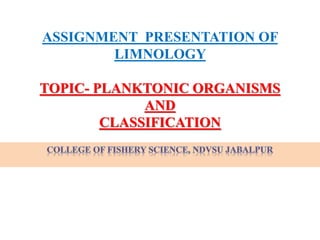
PLANKTONIC ORGANISMS AND CLASSIFICATION
- 1. ASSIGNMENT PRESENTATION OF LIMNOLOGY TOPIC- PLANKTONIC ORGANISMS AND CLASSIFICATION
- 2. PLANKTONIC ORGANISMS & CLASSIFICATION • What are planktons? • Diverse group of organisms living in large water bodies. • Unable to swim against water currents. • They provide a crucial source of food to large aquatic organisms. • Includes bacteria ,algae, archaic, protozoans & drifting or floating organisms.
- 3. • Found in pelagic zone of water bodies. • Essentially, they are defined by their ecological niche. • They are of wide ranges of sizes, including some microscopic organism & large organisms such as jelly fishes.
- 4. CLASSIFICATION PLANKTONS are classified into following group on The basis of their origin- • PHYTOPLANKTON • ZOOPLANKTON
- 5. PHYTOPLANKTONS • Derived from Greek word ‘python’ meaning plant. • Commonly are algae. • They are eukaryotic or prokaryotic algae. • They live near water surface where there is sufficient amount of light energy for photosynthesis. • Among the more important groups are diatoms, cyan bacteria, dinoflagellates and coccolithophores. • Inhabit upper sunlit layers of water bodies called euphotic zone.
- 6. • They are coloured due to presence of chlorophyll & acessory pigments such as phycobilliproteins & xanthophylls. • They are agents for "primary production” in aquatic food web. • Phytoplankton productivity is affected by changes in the vertical stratification of the water column, the rate of temperature-dependent biological reactions, and the atmospheric supply of nutrients .
- 7. PHYTOPLANKTONS AND AQUACULTURE • They are a key food item in aquaculture & mariculture. • Planktons are used as a food stock for the production of rotifers which are in turn used to feed the organisms. • The production of phytoplankton under artificial condition is itself a form of aquaculture. • The majority of cultured plankton is marine.
- 9. ZOOPLANKTONS • They are hetrotrophic sometimes detritivorus plankton. • The word zooplankton is derived from the Greek zoon meaning animals & planktons meaning wanderer. • Although they are transported by water currents,many have locomotion, used to avoid predators. • They are both holoplanktons & meroplanktons.
- 10. • Zooplanktons feed on bacterioplanktons or phycoplanktons. • They are found in surface water where food resources are abundant. • The physical factor that influences zooplankton distribution the most is mixing of water column that affects nutrient availibility & in turn phytoplankton production. • EXAMPLE • Rotifers, krills , radiolarians & pteropods.
- 12. CLASSIFICATION • On the basis of their cell size they are classified into following groups- • Bacterioplanktons • Nanoplanktons • Microplanktons • Macroplanktons
- 13. BACTERIOPLANKTONS • They are less than two microns. • Smallest phytoplanktons are represented by this group. • Example- • Bacillus , micrococus & bacterium.
- 14. NANOPLANKTONS • Size ranges from 2-20 microns. • Smaller phytoplanktons belong to this group. • They are flagellates. • Example- • Cocolithus & Gymnodium.
- 15. MICROPLANKTONS • Size ranges from 20 to 200 microns. • Large phytoplanktons & small zooplanktons belong to this group. • Example • Dinoflagellates- Ceratium & Dinophysis. • Diatoms- Chaetocerus
- 16. MACROPLANKTONS • Size ranges from 200 to 2000 microns. • Visible by naked eyes. • They includes copepods. • Example- • Calamus , Euphasia Superba (Antartic krills) • Antartic krills are food for whales.
- 17. Euphasia superba (Antartic krill)
- 18. MEGAPLANKTONS • They are exceptionally large organisms. • They are larger than 2000 microns. • Body posses tentacles which are quite long (15 m). • Example • Physalia
